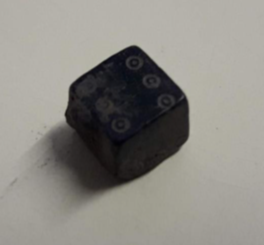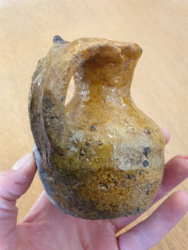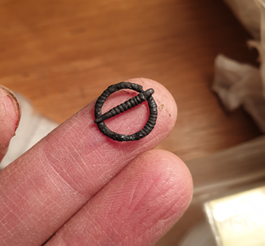09 Oct India Buildings: arguably the best medieval site ever excavated in Edinburgh.
Archaeological works at the site known as India Buildings have revealed arguably the best medieval site ever excavated in the city of Edinburgh.
The redevelopment of the existing India Buildings on Victoria St, Edinburgh into a new Virgin Hotel included the development of the land directly to the south, off the Cowgate to facilitate new construction.
The excavations were undertaken by AOC Archaeology from April 2018 to May 2019, and Headland Archaeology began the post excavation analysis in May 2023.
The site is nestled in in the eastern end of the valley of the Grassmarket, under the shadow of Edinburgh Castle and downslope from the Royal Mile. Numerous other excavations have taken place in this area; however due to the location at the base of the valley, the late medieval deposits in this area tend to contain material which has washed down from the High Street, or to reveal ‘backland’1 activity.
Yet India Buildings is markedly different, containing up to 4m depth of relatively undisturbed stratigraphy2, including an excellent sequence from the 12th to 19th centuries.
Post excavation analysis will focus on the well-preserved bulk of stratigraphy representing the 12th to 16th centuries but will also include untangling whether animal bones preserved beneath a layer of peat in the basal deposits of the site are in fact prehistoric in date.
The 12th century layers are of particular interest, as Edinburgh’s status as a burgh dates from around 1124AD when King David I introduced a new system of local government by creating royal burghs. The dating of these deposits may be able to tell us whether this area of the Cowgate was occupied pre, post or contemporary with this date.
The site also has the potential to feed into wider regional research in relation to the dendrochronological3 dating. From the wealth of waterlogged wooden material, including structural timbers, barrels, and wattle work; 91 dendrochronological dates will be obtained. These dates may prove crucial to completing the background tree-ring sequencing4 for the south-east of Scotland.
In addition to the dendrochronological dating, 100 C145 samples will be obtained from across the site (radiocarbon dating). Coupled with the pottery and finds dating, this will allow a robust chronology for the site and the archaeological features.
Unique preservation conditions on site has led to a wealth of organic finds, among these a barrel shaped leather water bottle known as a costrel with an imprinted armorial design. This find is unparalleled in Scotland, with only a few examples known in England. Alongside this were finds of over 100 leather shoes, 5 knife sheaths, textile fragments, wooden bowls and combs.
An enormous assemblage of ceramics were recovered from the site totalling 12,354 sherds, weighing in at 222kg. These include two near complete vessels as well as unusual forms such as dripping dishes, lamps, candlesticks and even a possible puzzle jug.
The animal bone assemblage from the site is even bigger. It comprises 779kg of animal bone dominated by domestic examples such as sheep, cattle and pig, but also includes examples of dog, cat, horse, deer, goose, fish and even seal, frog and rabbit. The site is located just off the Cowgate -which gets its name from the location that the cattle were brought in for market. Isotope6 analysis of the domestic animals will help us to understand where the animals were being brought from. Were they raised in town, in the nearby rural outskirts of Edinburgh, or brought from further afield such as cattle from the highlands?
Further assemblages of leather, horn and antler and metal artefacts hint at industrial activities. Unpicking the relationship between the assemblages and the features they come from will help us to understand whether these activities were taking place onsite and hopefully reveal more about the industries in this part of Edinburgh, and how they relate to each other over time.
Analysis of environmental the evidence in the form of shell, plant, insect, and parasite remains will also form a large part of the post-excavation process. This can highlight diet, environmental conditions and the presence of disease, helping to build a richer picture of life in Medieval Edinburgh.
Stay tuned with us for more information on the process and the findings!



Images: Left – 12th-13th century bone die, Middle – 13th-14th century tiny jug, Right – 13th-14th century tiny brooch.
Footnotes!
1 Backlands form part of the individual plots (known as burgage plots) in a medieval burgh. When plots were laid out from a relatively small width of high street frontage, they included a long strip of ‘backland’ stretching back from the high street property and usually terminating in a ditch. The backlands of burgage plots contained a multitude of activities including gardens, animal husbandry, further tenants and small-scale industrial activities.
2 Stratigraphy is the collective term given to the many layers of archaeological deposit within a site.
3 Dendrochronology is the science of dating using the patterns of annual growth rings in timber and tree trunks.
4 Background tree-ring sequencing: The practice of dendrochronological dating involves comparing the new sample to a known dated sample – a tree ring sample that has already been accurately dated to a year or year range. The background sequence refers to a continuous timeline of accurately dated samples to compare against. The more correctly dated samples we have, the easier, and more accurate new dating becomes. As tree rings are heavily influenced by climatic and environmental factors, these will be similar in trees from the same region. This is why a regional sequence with numerous accurate samples is important. Currently the south-east Scotland background sequence is only accurate for imported timber, not native timber.
5 All living things have Carbon. Carbon 14 (C14) are specific molecules that plants absorb from carbon dioxide, animals and humans then absorb these by eating the plants. When an animal or plant dies, the C14 begins to decline at a known rate. By measuring how much C14 is left in the organic matter, archaeologists can tell when it died.
6 Stable Isotopes are absorbed by people and animals from the things they eat. Being stable – they stay the same, meaning they are not broken down and instead are absorbed and redeposited in bones and teeth as they grow. By analysing these isotopes archaeologists can determine diet, which is influenced by location, giving us insights into where the animal or person lived.



